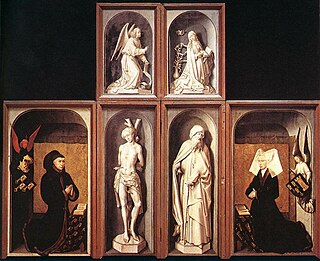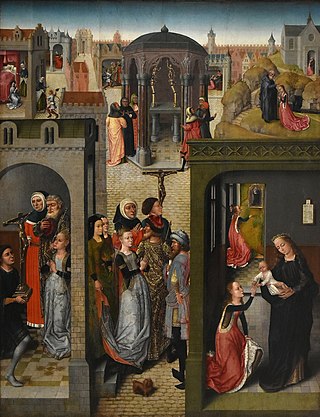
Gerard David was an Early Netherlandish painter and manuscript illuminator known for his brilliant use of color. Only a bare outline of his life survives, although some facts are known. He may have been the Meester gheraet van brugghe who became a master of the Antwerp guild in 1515. He was very successful in his lifetime and probably ran two workshops, in Antwerp and Bruges. Like many painters of his period, his reputation diminished in the 17th century until he was rediscovered in the 19th century.

Jan van Eyck was a Flemish painter active in Bruges who was one of the early innovators of what became known as Early Netherlandish painting, and one of the most significant representatives of Early Northern Renaissance art. According to Vasari and other art historians including Ernst Gombrich, he invented oil painting, though most now regard that claim as an oversimplification.

Early Netherlandish painting is the body of work by artists active in the Burgundian and Habsburg Netherlands during the 15th- and 16th-century Northern Renaissance period, once known as the Flemish Primitives. It flourished especially in the cities of Bruges, Ghent, Mechelen, Leuven, Tournai and Brussels, all in present-day Belgium. The period begins approximately with Robert Campin and Jan van Eyck in the 1420s and lasts at least until the death of Gerard David in 1523, although many scholars extend it to the start of the Dutch Revolt in 1566 or 1568–Max J. Friedländer's acclaimed surveys run through Pieter Bruegel the Elder. Early Netherlandish painting coincides with the Early and High Italian Renaissance, but the early period is seen as an independent artistic evolution, separate from the Renaissance humanism that characterised developments in Italy. Beginning in the 1490s, as increasing numbers of Netherlandish and other Northern painters traveled to Italy, Renaissance ideals and painting styles were incorporated into northern painting. As a result, Early Netherlandish painters are often categorised as belonging to both the Northern Renaissance and the Late or International Gothic.

The Mérode Altarpiece is an oil on oak panel triptych, now in The Cloisters, in New York City. It is unsigned and undated, but attributed to Early Netherlandish painter Robert Campin and an assistant. The three panels represent, from left to right, the donors kneeling in prayer in a garden, the moment of the Annunciation to Mary, which is set in a contemporary, domestic setting, and Saint Joseph, a carpenter with the tools of his trade. The many elements of religious symbolism include the lily and fountain, and the Holy Spirit represented by the rays of light coming through from the central panel's left hand window.

Petrus Christus was an Early Netherlandish painter active in Bruges from 1444, where, along with Hans Memling, he became the leading painter after the death of Jan van Eyck. He was influenced by van Eyck and Rogier van der Weyden and is noted for his innovations with linear perspective and a meticulous technique which seems derived from miniatures and manuscript illumination. Today, some 30 works are confidently attributed to him. The best known include the Portrait of a Carthusian (1446) and Portrait of a Young Girl ; both are highly innovative in the presentation of the figure against detailed, rather than flat, backgrounds.

The Beaune Altarpiece is a large polyptych c. 1443–1451 altarpiece by the Early Netherlandish artist Rogier van der Weyden, painted in oil on oak panels with parts later transferred to canvas. It consists of fifteen paintings on nine panels, of which six are painted on both sides. Unusually for the period, it retains some of its original frames.

The Donne Triptych is a hinged-triptych altarpiece by the Early Netherlandish painter Hans Memling. It consists of five individual panel paintings: a central inner panel, and two double-sided wings. It was painted for the soldier, courtier and diplomat Sir John Donne, probably sometime between the late 1470s or early 1480s, and contains portraits of Donne, his wife and daughter. It is kept in the collection of the National Gallery, London, with the panels still in their original frames.

Saint Luke Drawing the Virgin is a large oil and tempera on oak panel painting, usually dated between 1435 and 1440, attributed to the Early Netherlandish painter Rogier van der Weyden. Housed in the Museum of Fine Arts, Boston, it shows Luke the Evangelist, patron saint of artists, sketching the Virgin Mary as she nurses the Child Jesus. The figures are positioned in a bourgeois interior which leads out towards a courtyard, river, town and landscape. The enclosed garden, illusionistic carvings of Adam and Eve on the arms of Mary's throne, and attributes of St Luke are amongst the painting's many iconographic symbols.

The Werl Triptych is a triptych altarpiece completed in Cologne in 1438, of which the centre panel has been lost. The two remaining wings are now in the Prado in Madrid. It was long attributed to the Master of Flémalle, now generally believed to have been Robert Campin, although this identity is not universally accepted. Some art historians believe it may have been painted as a pastiche by either the workshop or a follower of Campin or the Master of Flémalle.

The Virgin and Child with Canon van der Paele is a large oil-on-oak panel painting completed around 1434–1436 by the Early Netherlandish painter Jan van Eyck. It shows the painting's donor, Joris van der Paele, within an apparition of saints. The Virgin Mary is enthroned at the centre of the semicircular space, which most likely represents a church interior, with the Christ Child on her lap. St. Donatian stands to her right, Saint George—the donor's name saint—to her left. The panel was commissioned by van der Paele as an altarpiece. He was then a wealthy clergyman from Bruges, but elderly and gravely ill, and intended the work as his memorial.

Triptych of the Sedano family is an oil-on-panel triptych altarpiece by the Early Netherlandish painter Gerard David, usually dated between 1490 and 1498, probably c. 1495. It is noted for its innovative framing and for its rendering of the decorative oriental carpet seen at Mary's feet.

The Master of the Prado Adoration of the Magi was a Netherlandish painter active between c. 1475 and 1500 whose identity is now lost. He is thought to have originated from the southern Netherlands and is known for his vibrant colourisation in panels depicting scenes from the infancy of Christ, he is thought to have been a pupil of Rogier van der Weyden, and is named after a copy of the "Adoration of the Magi" panel from that painter's St Columba Altarpiece. Although the Magi became a popular topic for northern painters in the second half of the 15th century and the Columba altarpiece was widely copied, the master is associated with van der Weyden's workshop because the copy is so close, it is believed he must have had access to a reproduction of the underdrawing.

Madonna of the Dry Tree or Our Lady of the Barren Tree is a small oil-on-oak panel painting dated c. 1462–1465, attributed to the Early Netherlandish painter Petrus Christus. Its dramatic imagery shows the Virgin Mary holding the Christ Child within a tree, surrounded by black, withered branches forming a crown of thorns.

The St John Altarpiece is a large oil-on-oak hinged-triptych altarpiece completed around 1479 by the Early Netherlandish master painter Hans Memling. It was commissioned in the mid-1470s in Bruges for the Old St. John's Hospital (Sint-Janshospitaal) during the building of a new apse. It is signed and dated 1479 on the original frame – its date of installation – and is today still at the hospital in the Memling museum.

The Master of the Legend of Saint Catherine is the notname for an unknown late 15th century Early Netherlandish painter. He was named after a painting with Scenes from the Legend of Saint Catherine, now kept in the Royal Museums of Fine Arts of Belgium. He was active between c. 1470 and c. 1500, probably around Brussels.

The Annunciation is an oil painting by the Early Netherlandish painter Hans Memling. It depicts the Annunciation, the archangel Gabriel's announcement to the Virgin Mary that she would conceive and become the mother of Jesus, described in the Gospel of Luke. The painting was executed in the 1480s and was transferred to canvas from its original oak panel sometime after 1928; it is today held in the Robert Lehman collection of the Metropolitan Museum of Art in New York.

The Saint Columba Altarpiece is a large c. 1450–1455 oil-on-oak wood panel altarpiece by Early Netherlandish painter Rogier van der Weyden painted during his late period. It was commissioned for the church of St. Columba in Cologne, and is now in the Alte Pinakothek, Munich. It depict scenes from the early life of Jesus. They show, from left to right, the Annunciation, the Adoration of the Magi and the Presentation, when she presents the infant at the Temple in Jerusalem. In each panel, Mary is distinguished by her blue clothes. The reverse of the exterior panels are covered with plain paint and lack indication that they ever contained donor portraits as were typical for the time.

Portrait of Maria Portinari is a small c. 1470–72 painting by Hans Memling in tempera and oil on oak panel. It portrays Maria Maddalena Baroncelli, about whom very little is known. She is about 14 years old, and depicted shortly before her wedding to the Italian banker, Tommaso Portinari. Maria is dressed in the height of late fifteenth-century fashion, with a long black hennin with a transparent veil and an elaborate jewel-studded necklace. Her headdress is similar and a necklace identical to those in her depiction in Hugo van der Goes's later Portinari Altarpiece, a painting that may have been partly based on Memling's portrait.

The Moreel Triptych is the name given to a 1484 panel painting by the Early Netherlandish painter Hans Memling. It was commissioned by the prominent Bruges politician, merchant and banker Willem Moreel and his wife Barbara van Vlaenderberch, née van Hertsvelde. It was intended as their epitaph at the chapel of the St. James's Church, Bruges, an extension they had paid for.

The Pagagnotti Triptych is an oil-on-wood triptych by Hans Memling produced circa 1480. The original was disassembled and separated, with the center panel held at the Uffizi gallery in Florence and the two wing panels at the National Gallery in London.

























